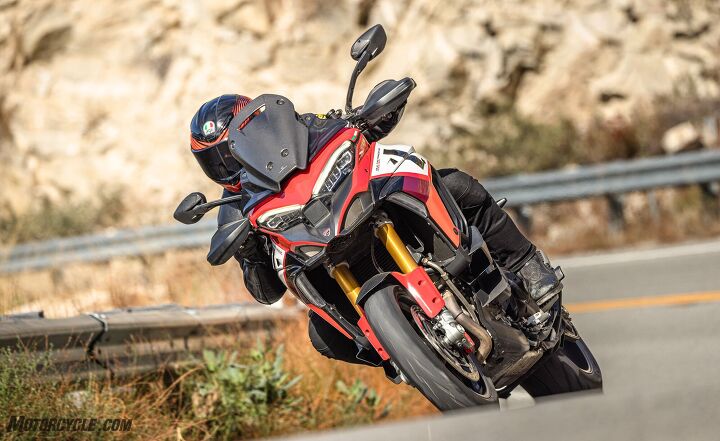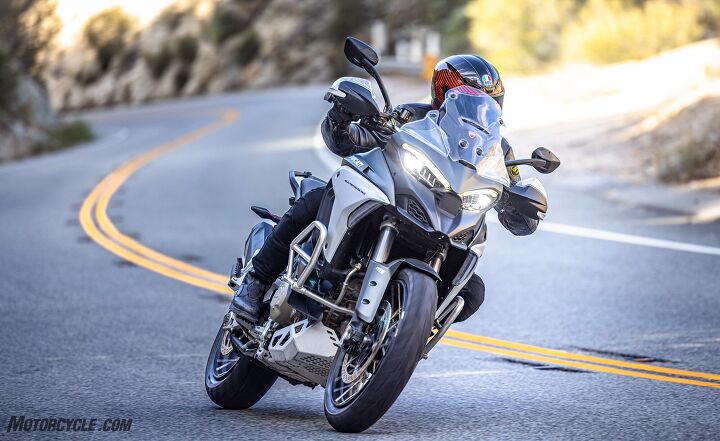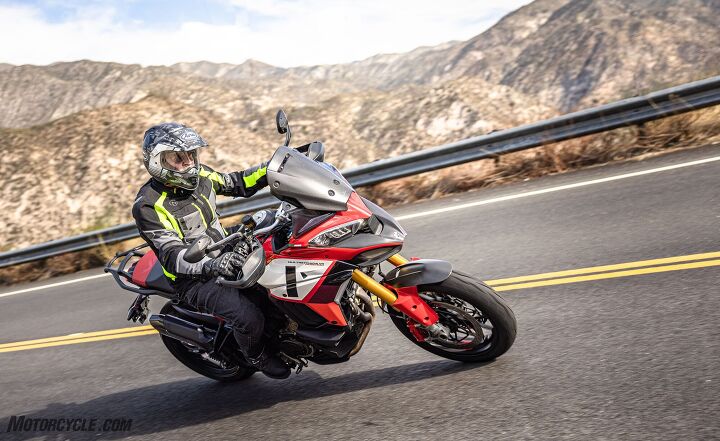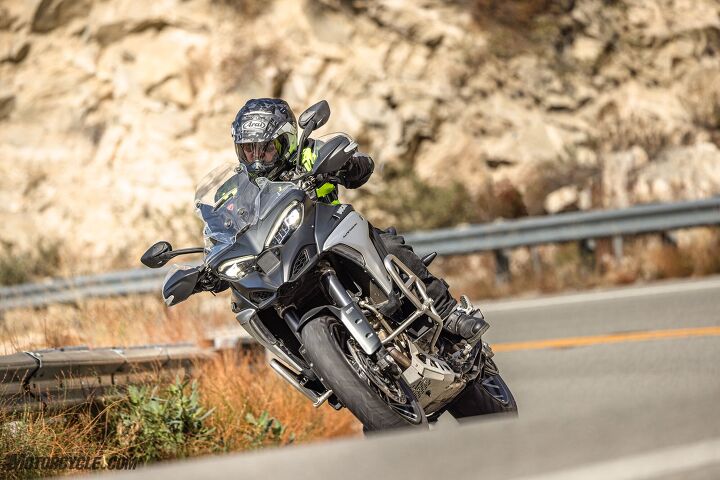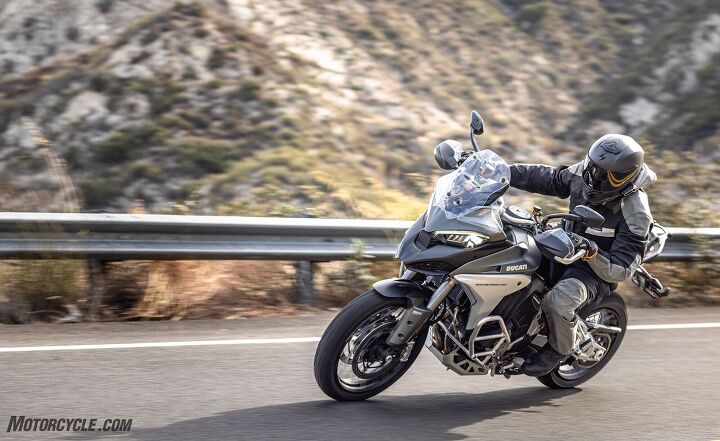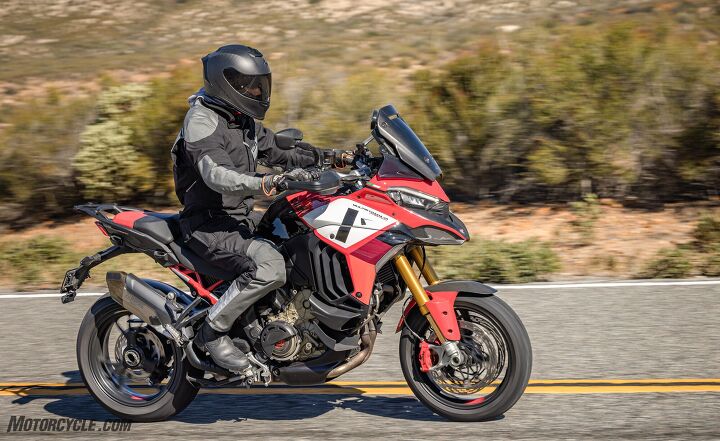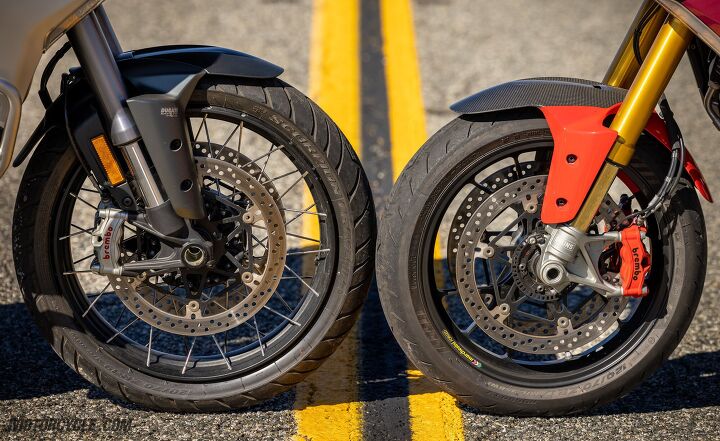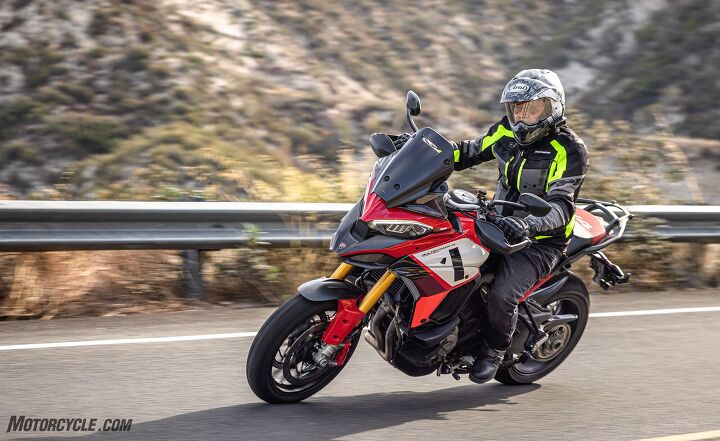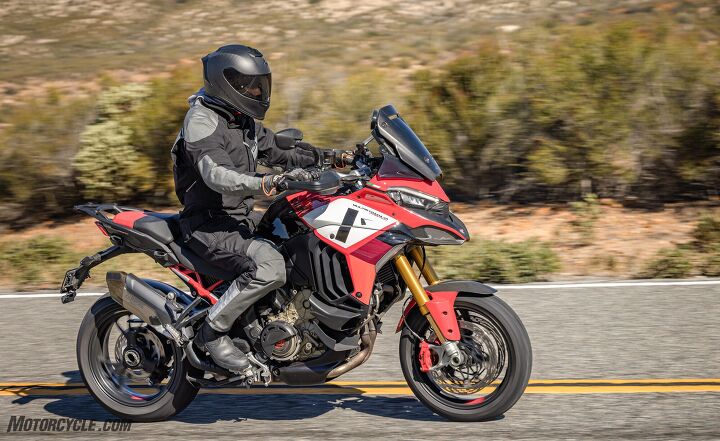Motorsports Racing News & Blog Articles
The Final Front Tire: Which is better for your ADV bike? 19 or 17-inch?
It all began when our old friend Ken Vreeke returned from a six-day ride in Spain, name-dropping and in love with the BMW S1000XR he’d ridden there. Actually, he rented a GS1250, but also got some time on the XR: Problem is with the ADV bikes, Vreeke complains, even with good tires you run off the edges long before you get any real lean angle. My tires on the rented GS were new, and the front was bald on both sides after a week in Spain. Chasing EB, I kept running out of tire at the precise moment he was grabbing a big mittful of gas and launching away. When I finally got on the XR on the last day, I was shocked at how much throttle you could feed in leaned waaaaay over. I’ve only ridden one modern Superbike – that Kawasaki H2 you brought around – so the XR blew my mind. It was soooooo stuck to the road.
The EB the Vreekster was chasing was Eric Bostrom, so you can surmise the pace was relatively spirited. It’s generally accepted that ADV bikes with 19-inch front tires are going to be better off pavement, and ones with 17-inch fronts will be better on it. But we’ve never really broken that down before? How much better?
Adventure riding, being able to turn down dirt roads, has become a big thing. But a lot of us of a certain age grew up separating dirt riding from road riding, one at a time. And we still want to burn down the pavement occasionally, no compromises, without having to assume the sportbike position. Ken, who already has a KTM Adventure bike and a bad back (and front, and sides), is a prime example: I’m not looking for an ADV bike. Love my 1290 Super Adventure and plan to keep it. What I need is a streetbike with 17s that can take real tires, so I don’t have to slither around all day, with ADV-type ergos. And so I can do the occasional track day on slicks.
Well, ahhh, near as we can tell, there are but two motorcycles that fit that description: the BMW S1000XR, and the Ducati Multistrada V4 Pikes Peak. (Wait: The Kawasaki Versys 1000 SE LT also belongs!) We lined up the BMW and the Duc for a nice little comparison test. But, when everybody’s schedule got complicated and Vreeke couldn’t ride with us on the appointed day, we decided to eliminate as many other variables as we could, except wheel size, by comparing Ducati’s 19-inch front-wheeled Multistrada V4S, with the Bolognese 17-in. tired Multistrada Pikes Peak. The BMW, we’ll save for another test.
Best Sport-Touring Motorcycle of 2021
What’s the difference?
Both bikes are powered by Ducati’s first non-Desmo engine in the modern era, an 1158cc counter-rotating V4 said to put out 170 crankshaft horsepower, and 92 pound-feet of torque at just 8750 rpm; both use the same basic aluminum monocoque frame.
2022 Ducati Multistrada V4 Pikes Peak Review: First Ride
The most obvious difference is that the Pikes Peak rolls on racy 17-in. Pirelli Diablo Rosso IV rubber front and rear, while the V4S is turned out in 19-/17-in. Pirelli Scorpion Trail II tires. Less apparent to the naked eye is that the forged aluminum Marchesini wheels on the PP weigh 5.9 pounds less than the cast ones on the V4S (and regular V4, too), and that our bike has the even heavier wire-spoke option. Add to that a 19-in. tire weighs, on average, 20% more than a 17-in. one of the same type.
Also, while suspension travel is really close between the two Multis – 6.7 in. travel front and rear on the Pikes Peak, 6.7 and 7.1 for the V4S – the suspension itself is completely different: The PP gets the latest Smart EC 2.0 Öhlins suspension just like what the Panigale V4 S and Streetfighter V4 S use. This is “a particularly advanced system that allows an `event based’ adjustment, according to the rider’s riding style.” Meanwhile, the V4S soldiers on with the “Skyhook” electronic suspension that’s now been around for a while. It’s still excellent, but its design goal isn’t “maximum sport” like the Panigales and the Pikes Peak.
And let’s not forget that there are also ergonomic differences between Pikes Peak and V4S. The PP’s footpegs are 10mm higher and rearward compared to the other Multis, and an 18mm narrower handlebar set lower and more forward pulls the rider slightly more over the PP’s front wheel. It’s very subtle, but it’s there.
We’ll need a Maniac
Going into it, based on my past experience riding powerful late-model ADV bikes on the road, I felt like I could not, or could barely tell the difference between a premium 19 and 17-inch front tire on the street: Most premium 19-inch tires hold the road so well, IMU-based rider aids are so highly evolved, and my keen sense of self preservation in my sixth decade of life had me thinking we’d need a real maniac to be able to parse the differences. Hence, Vreeke. I’ve never climbed off a big BMW GS or KTM Adventure with a 19-in. front and said to myself, `Gee, I coulda gone faster on a 17-in. front tire.’ Then again, when I think about it, maybe I’ve only ever ridden 19-inch front-wheel bikes in the company of other 19 (or 21-in.) ADV bikes?
Instead of Vreeke, we dragged semi-maniacal Troy Siahaan and Mike Vienne out onto the Brasfield 100-mile loop on a beautiful November SoCal day – a nice outback route with a wide array of curves, speeds, bumps, smooth sections, and humps.
The Chase
As it turns out, I need not have worried. Once rolling and up to operating temperature, it seems like whoever was on the Pikes Peak had less work to do to hang with the group, and the tighter the curves, the easier it was for the PP to gap the rest of the field. It almost felt like cheating. There’s very little wasted motion on the Pikes Peak as it rolls easily into corner after corner, feeding back precise feel through its dirt-bikey handlebar while its amazing electronic suspension keeps it constantly and firmly even-keeled. And though both Multis spec Stylema calipers on 330mm dual discs, the PP stops harder too. Must be a pad thing (and an intentional one, since you want less initial bite off pavement). You probably could’ve won the Daytona 200 on the Pikes Peak last year with your stuff in the saddlebags.
Troy says: You really feel the difference between the 17-inch wheel on the Pikes Peak and the 19-incher on the standard bike in tighter corners or switchbacks when you really have to toss the bike from side to side. Even (especially) parking lot maneuvers are a little more sluggish with the 19-inch wheel, and require a little more bar input. Not surprisingly, the Pikes Peak and its 17-inch front wheel was easier to flick and move around in the canyons, and even just doing U-turns and slow-speed turning.
The Problem
The problem, though, is it’s impossible to fully credit the PP’s 17-in. front tire when there are so many other variables. Though they both have almost identical travel, the V4S’ suspension is way more compliant than the Pikes Peak’s Smart EC 2.0 Öhlins suspension when both bikes are in Sport mode, which results in a lot more fore-and-aft pitching on and off the gas. The S’ taller, wider handlebar makes it feel like a longer journey from full lean to full lean (though seat heights are the same 33.1 to 33.9 in.).
And the heavier wheelset on our V4S doesn’t do the 19-inch front any favors when it comes to side-to-side transitions in the tight sections. Crash bars and skid plate add weight too. Poor thing has one hand tied behind its back.
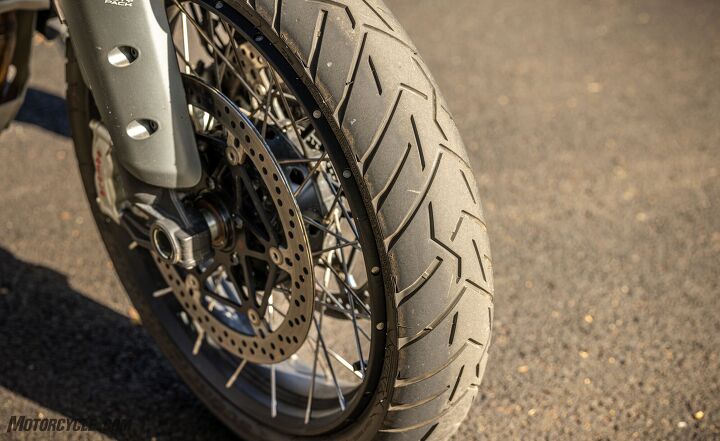
The tubeless spoke wheels (a $700 option) are even heavier than the cast aluminum ones that are standard on the V4S. The rain grooves on the Pirelli Scorpion Trail IIs go all the way to the edges of the tire, where the chicken strips are nearly gone…
The V4S has less trail than the PP – 4.0 in. to 4.7 – and an inch-shorter wheelbase: 61.7 to 62.8 inches. Both numbers quicken the S’s steering, but not enough to close the Pikes Peak gap.
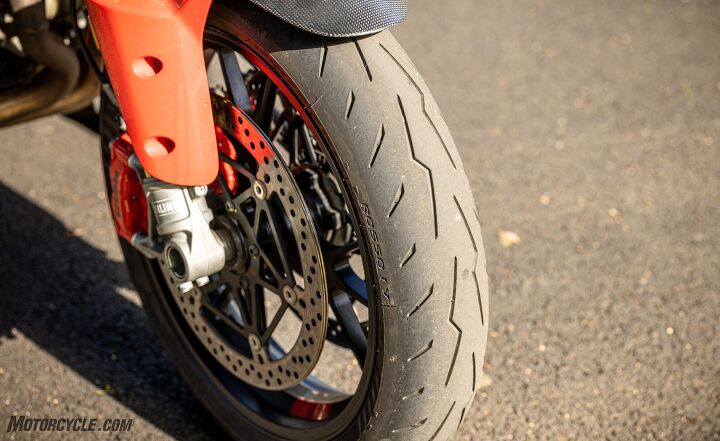
The Pikes Peak’s Rosso Corsa IV lets it be ridden faster, easier, and more confidently (on pavement!), and at the end of the day there’s still plenty of virgin rubber in reserve for a track day.
Meanwhile, the Peak’s “event-based” active suspension takes into account how hard you’re twisting the throttle, how hard you’re braking, and how quickly the IMU sensor is banging around, to firm things up exactly as needed. It works just as well on the Multi as it did on the Streetfighter V4 that won our big naked bike comparison last year.
All the things that slow the V4S on twisty pavement, of course, are just the ones you want when the pavement ends: More upright ergos and more handlebar leverage, softer suspension to absorb bumps and jumps at lower speeds, and more spinning mass for greater gyroscopic self-righteousness. Physics says angular momentum of a rotating body increases with radius (provided the rotational speed stays the same), but how much would the difference shrink if the V4S’ 19-in. front was also a forged Marchesini like the Pikes Peak’s? (Which would also be easier to bend, so it’ll never happen.) The 17-in. tire’s contact patch is wider, but the 19’s is longer… In a perfect world, we’d swap the wheels between our two Ducatis and ride them again, but doing so would freak out the electronics and probably our friends at Ducati North America.
Electronics
It wouldn’t have hurt if we’d stiffened the V4S suspenders up from the basic Sport mode, but the more convenient things become, the lazier we get. It would’ve helped the S, but it wouldn’t have closed the gap to the Pikes Peak. If we’d done a dirt section, the tables would’ve been turned. Mike Vienne says he could feel the lesser stability of the PP’s smaller front wheel just pulling into gravel turnouts. He’s right. Then again, I’m with Vreeke, who argues that traction control and ABS go a long way toward making up for less than ideal tires on not-too gnarly terrain like the typical fire road, once you’re rolling:
Even with the 80/20 street bias tires you can ride like an as***le on fireroads, says Ken, because the electronics are so good. That’s why the tire percentage descriptions no longer work, and why absolute shit tires that go 20k miles won’t maybe kill you – whereas before it was a certain dirt bath. Electronic angels at work.
The Multi V4S offers an Enduro mode in addition to Sport, Touring, and Urban. The Pikes Peak does away with Enduro, substituting a Race mode instead, and encouraging you to sign up for track days in the process.
Also, on some of these powerful bikes, the traction control out back is so good, it makes it too easy to push the front on pavement, which was the original Vreeke complaint:
My main issue w 17 v 19 is tire selection for sport-type riding. The Dunlop TrailSmart was the best tire I tested by far, and acted like a real tire with grip, but the brain trust there decided to discontinue it. (Dunlop said the TrailSmart was an 80%-onroad tire, 20% offroad; the TrailMax Mission that replaces it is marketed as a 50/50.)
Tires are by far the street handling limit on my KTM 1290 SA (also a 19-in front) due to rim diameter and width. If there’s a TrailSmart equal out there, and there probably is, I haven’t tried it yet. I’m currently on Dunlop Mutants and they work well. But no magic.
That said, going any faster is probably dumb, but less dumb since bikes with 17s just leave a much wider safety margin. It boils down to a safety issue for me. How big is my margin? That S1000XR was like a 600 compared to the GS1250, and the weight difference is not massive. It was waaay easier to pick up the pace on the XR. GS was like a hippo on little cat feet.
Probably dumb
Hmmm. I was surprised to learn that I really could tell the difference between the 19 and the 17, and a pretty dramatic one at that. If the Pikes Peak hadn’t been along for the ride, it would be easy enough to think you were making great time on the V4S in those swervy backroads.
On the PP, though, I could dial up a pace in the curves that would make the other fellas grow smaller in my mirrors (for a second or two anyway), and it was easy to keep up that aggressive-ish pace for miles of curves. But when Mike and T. Siahaan were on the 17-in. PP and the S1000XR, and I was on the V4S, it was hard, perspirey work to keep up – and I eventually couldn’t keep those guys in sight. Reasonably conclusive evidence that the 17 is what you want for maximum pavement performance. Did everybody already know this?
What’s the Point?
The point is that if you’re after that old-timey superbike experience on the road, but want something comfortable that you can ride for days at a time, the Multistrada Pikes Peak is almost a party of one. The 17 front makes it way quicker to change direction, and gives more positive grip leaned over. In a perfect world, we’d compare the exact same tire in 17 and 19-in sizes on the same bike with the same suspension. But I think we’d still reach the same conclusion, though maybe not quite so conclusively.
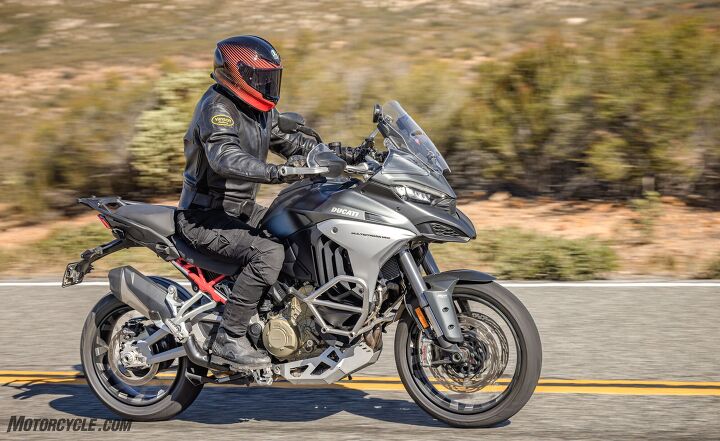
Mikey likes the V4S. Aesthetically, I have to say the Multi looks like it was designed for the 19-incher… the 17 gives it a bit of a receding chin.
Nice bikes…
We tried to make it just about the wheels and tires, but we couldn’t help comparing the bikes a bit while we were at it. Mike Vienne says he’d rather have the V4S and a Streetfighter V4 to fill the Pikes Peak role, which takes the MO Coastal Elite Wretched Excess Record for now:
The Pikes Peak checks all the boxes. V4. Dry clutch. Good suspension and brakes. Lightweight wheels. Tech, modes, good looks. On paper this is a slam dunk. But here’s my issue. Why?
I can have all of that without the added height and weight penalties in the Ducati V4S Streetfighter. Yes, the Streetfighter would fail comically off road. But I wouldn’t take the Pikes Peak offroad either. Isn’t that why the Multistrada with the 19-in front wheel exists? The Pikes Peak is the motorcycle equivalent of some turbo’ed Sport SUV RR Track Prep Edition – you know, the kind with 700 hp, no ground clearance, and weighs 3 tons. For all their extreme 4X4 posturing, they never handle as well as a sports car and they suck at off-roading (which they never do anyway). So what’s the point? I’m asking you, Pikes Peak.
I think it’s because you can throw the missus on back of the Pikes Peak and some luggage, Mike, and leave her at the youth hostel in Palm Springs while you do a track day at Chuckwalla. Unfeasible on the Streetfighter. Or, cruise cross-country to Brasfield’s high-school reunion with the adaptive cruise control set. You could do both of those a bunch of times before the valves need adjusting, too.
Let’s have Trizzle play us out:
I get the V4S. It’s supposed to be one bike to do it all. And you know what? It really does. But I’m not the rider who does it all. If I find myself on a huge motorcycle off in the dirt, then something has gone seriously wrong. I’m using a bike like this on pavement, and in that regard the 17-inch wheels are clearly the better choice. Obviously the 19-incher can do the job – and do it quite well I might add – but even at a brisk street pace I could tell that I was nearing the edge of the big tire’s traction (and profile – just look at the chicken strips). Not to mention the inherent sluggishness of the bigger wheel in tighter confines. But I will admit, the lighter clutch pull of the V4S was nice, as was the quietness of the wet clutch.
Like Mike, I’d veer towards the Streetfighter, but if I could only pick one bike to do all the pavement riding I enjoy (which also includes sport-touring), it’s hard to beat the Pikes Peak. It’s fast as hell, handles like a sportbike, and is comfortable enough to have the missus hop on the back and go for a weekend joy ride (with some luggage, of course). While the Pikes Peak is more than just some 17-inch wheels, they’re clearly the defining factor that helps it achieve these traits. You can actually use good (great) tires, haul ass, and still have a wide buffer before hitting the limits of your rubber.
Best of all – the Pikes Peak has RED Brembo calipers!
|
John’s Gear Helmet: Arai XD4 |
|
Troy’s Gear Helmet: Scorpion EXO R1 Air |
| Specifications | Ducati Multistrada V4 S | Ducati Multistrada V4 Pikes Peak |
|---|---|---|
| MSRP | $26,895 | $30,395 |
| Engine Type | V4 Granturismo, V4 – 90°, 4 valves per cylinder, counter-rotating crankshaft, Twin Pulse firing order, liquid-cooled | |
| Displacement | 1,158 cc (71 cu in) | |
| Power | 170 hp at 10,500 rpm (claimed) | |
| Torque | 92 lb-ft. at 8,750 rpm (claimed) | |
| Front Suspension | Ø 50 mm fully adjustable usd fork, electronic compression and rebound damping adjustment with Ducati Skyhook Suspension | Öhlins Ø 48 mm fully adjustable usd fork with TiN treatment, electronic compression and rebound damping adjustment with Öhlins Smart EC 2.0 event-based mode |
| Rear Suspension | Fully adjustable monoshock, electronic adjustment with Ducati Skyhook Suspension, aluminum double-sided swingarm | Öhlins TTX36 fully adjustable monoshock, electronic compression and rebound damping adjustment with Öhlins Smart EC 2.0 event-based mode, electronic preload adjustment, aluminium single-sided swingarm |
| Wheel Travel (Front/Rear) | 6.7 inches / 7.1 inches | 6.7 inches / 6.7 inches |
| Front Wheel | Light alloy cast, 3″ x 19″ (tubeless wire-spoke optional) | Marchesini light alloy forged, 3.5″ x 17″ |
| Front Tire | Pirelli Scorpion Trail II 120/70 ZR 19 | Pirelli Diablo Rosso IV 120/70 ZR17 |
| Rear Wheel | Light alloy cast, 4.5″ x 17″ (tubeless wire-spoke optional) | Marchesini light alloy forged, 6″ x 17″ |
| Rear Tire | Pirelli Scorpion Trail II 170/60 ZR 17 | Pirelli Diablo Rosso IV 190/55 ZR17 |
| Front Brake | 2 x Ø 330 mm semi-floating discs, radially mounted Brembo Stylema monobloc 4-piston 2-pad calipers, radial master cylinder, Cornering ABS | |
| Rear Brake | Ø 265 mm disc, Brembo 2-piston floating caliper, Cornering ABS | |
| Curb Weight | 536 pounds (claimed, + optional spoke wheels on our bike, crash bars, skidplate) | 527 pounds (claimed) |
| Seat Height | Adjustable, 33.1 inches – 33.9 inches | |
| Wheelbase | 61.7 inches | 62.8 inches |
| Rake x Trail | 24.5°/4.0 inches | 25.75°/4.7 inches |
| Fuel Tank Capacity | 5.8 US gallons | |
| Number Of Seats | 2 | |
| Safety Equipment | Riding Modes, Power Modes, ABS Cornering, Ducati Traction Control, Ducati Wheelie Control, Daytime Running Light, Ducati Cornering Light, Ducati Brake Light, Vehicle Hold Control | |
| Standard Equipment | Ducati Skyhook Suspension, Ducati Quick Shift, Cruise control, Hands-free, Backlit handlebar switches, 6.5″ TFT color display with Ducati Connect and full-map navigation system, Full LED headlight | Öhlins Smart EC 2.0 electronic suspension, Ducati Quick Shift, Adaptive Cruise Control, Hands-free, Backlit handlebar switches, 6.5″ TFT colour display with Ducati Connect and full-map navigation system, Full LED headlight, Carbon fiber front mudguard and beak, Type-approved Akrapovic muffler, Two-tone seat |
We are committed to finding, researching, and recommending the best products. We earn commissions from purchases you make using the retail links in our product reviews. Learn more about how this works.
Become a Motorcycle.com insider. Get the latest motorcycle news first by subscribing to our newsletter here.
The post The Final Front Tire: Which is better for your ADV bike? 19 or 17-inch? appeared first on Motorcycle.com.
Copyright
© Motorcycle.com


